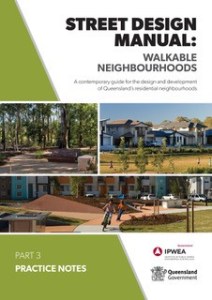University campuses have much in common, including the likelihood of getting lost and disorientated. This is largely due to the way each campus evolves with new buildings placed wherever land is available. That makes architectural wayfinding strategies impossible to follow. So if a university campus can come up with a good way of orientating people, it should be good for other situations.
There are a large number of buildings present on Edith Cowan University campuses which cannot be changed to accommodate intuitive, architectural wayfinding practices.

Wayfinding is essential for helping people to get out and about. Getting lost is not just inconvenient, it is stressful – especially if it causes a late arrival. The Wayfinding Signage Manual for Edith Cowan University outlines how and where signs should be used, designed and built. It is a technical document with a destination hierarchy, application strategy and graphic standards. An access and mobility map and an active transport map are also included.
Wayfinding and signage for walkers
The Queensland Department of Transport and Main Roads also has a guide for people walking. This is another technical document offering specific guidance to wayfinding professionals. While walkers (and wheelers) have specific requirements they need to be woven into signage for cyclists. Well-designed wayfinding and signage encourages people to walk using routes that are safe.
People walking have specific wayfinding needs different from those riding bikes or motorists.

The guide for people walking has a section on accessibility and lists several design elements to support accessible wayfinding signage. The wayfinding manual developed by the Cooperative Research Centre is referenced in this document. Although it was researched and developed in 2007 it remains an excellent reference.
Getting around QUT
Similarly to Edith Cowan University, the Queensland University of Technology (QUT) has a wayfinding signage manual. This rather lengthy document is also technical and was published in 2022. It begins with a wayfinding masterplan, signage principles and accessibility. It’s good to see accessibility at the beginning of the guide – this aspect is often left until last.

 New residential developments in Queensland must be walkable and encourage physical activity. Specific legislation requires among other conditions, connectivity, footpaths and street trees. B
New residential developments in Queensland must be walkable and encourage physical activity. Specific legislation requires among other conditions, connectivity, footpaths and street trees. B Real life examples are included in a
Real life examples are included in a 






 Facelift is a new AI system that allows urban planers to redesign the look of city streets.
Facelift is a new AI system that allows urban planers to redesign the look of city streets. 







 Wayfinding is often considered as just signage instead of site or building legibility. A wayfinding system involves buildings, open space, lighting, and landmarks. It’s about providing consistent clues to help people navigate indoor and outdoor spaces.
Wayfinding is often considered as just signage instead of site or building legibility. A wayfinding system involves buildings, open space, lighting, and landmarks. It’s about providing consistent clues to help people navigate indoor and outdoor spaces. 

 Are high rise developments good for children? This is the key question in
Are high rise developments good for children? This is the key question in 
 The
The 